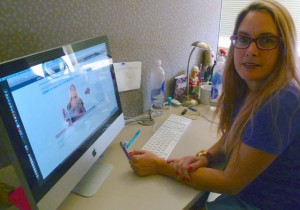Marcum Martz and his two teenage sons signed up to take the intro to computer programming course through San Jose State and Udacity over the summer. He says that, right off the bat, he noticed big problems.
“It became fairly obvious that the course content, the quizzes, the assignments and the way in which the class proceeded had not been beta tested thoroughly, if at all,” Martz says.
He might let that slide if the class were a normal, free MOOC. Instead, Martz paid $150 each for him and his sons to take the class and earn college credit.
Taking the courses for credit meant doing extra assignments, getting access to instructors and receiving actual grades.
Universities hope this model will get more kids through bottleneck classes -- like entry-level math and science -- and on to graduation.
The problem is that students didn’t do well in the first semester’s classes. In remedial math, nearly 80 percent of students failed. In elementary statistics, roughly half failed.
New Models, New Challenges
“We clearly should not be trying to take this Orville and Wilbur machine across the Atlantic Ocean,” says Peter Hadreas, professor and philosophy department chair at San Jose State. “It’s treated like the Concorde and it’s ready to go, but in fact it’s a way of teaching that’s in a very formative stage.”
Hadreas is not just concerned about his school's Udacity pilot. Variations on MOOC experiments are showing up in lots of different places.
Last spring, San Jose State administrators asked Hadreas’ department to use an EdX MOOC to “flip” an ethics class, or have students watch the online class at home and use class time to work on assignments with local professors. The university had successfully used the method the prior semester to boost completion rates in a circuitry course.
After watching the ethics MOOC, taught by Harvard professor Michael Sandel, the San Jose philosophy faculty wrote an open letter in protest. Hadreas says it would be insulting to force diverse state university students to watch the Ivy League professor lecture to his affluent class.
“He would incorporate into his talks how privileged they were,” Hadreas says. “They were for the most part more white than our student body. So we got on the one hand this strange upstairs-downstairs situation, where the lower-class people could look at how the upper-class people were educated.”
He says the political science department also took issue with the format and refused to teach the class.
Another problem that’s causing concern is something called the "digital divide." Some high school students in the first-semester Udacity pilot didn’t have computers, as the Oakland Tribune reported.
Public-Private Partnership
The greatest worry that instructors have, though, is privatization, Hadreas says.
Some MOOC providers are for-profit companies. Right now, they live off venture capital and give their content to universities for cheap or free.
Professors say that can’t last. So they question who will pay for the months of work it takes to turn instructors’ lectures into scripts, shoot dozens of videos, and edit together the polished package.
Susan Snycerski, a full-time lecturer at San Jose State who co-developed an Intro to Psychology class for the Udacity pilot, says it took more effort to create than a traditional in-person class.
“It’s been an enormous amount of time,” she says. “I had no idea when I signed up how much time.”
Here’s her outline of the process:
- Divide up the course into sections
- Choose which instructor would write the lesson plans for each section
- Type out complete lectures for each lesson plan (Snycerski says some lectures were 17-20 single-spaced, typed pages)
- Vet/edit lectures
- Submit lectures to Udacity producer to turn into video scripts
- Decide what types of shots to use for each lecture (headshot, reenactment, writing on tablet, etc)
- Make multiple trips to Udacity studio in Mountain View to record lesson segments (Snycerski says at times she was at Udacity for eight hours a day, four days a week)
- Review videos
- Fix errors
Snycerski says she's proud of her work, but the hours, criticism and politics have been tough.
“I would continue teaching my course,” Snycerski says. “I wouldn’t make a new course. I think right now, I'm just done.”
Evaluation Time
Everyone at San Jose State is done for the time being. After seeing the project's initial results, university President Mo Qayoumi agreed to put it on pause.
Qayoumi is adamant that the university is not giving up on the experiment. He says the hiatus will allow for a deeper analysis of the data.
“As we look at new approaches, sometimes we need to go back and adjust that and learn from it,” Qayoumi says. “Universities should be a place for exploration.”
Parent Marcum Martz wants universities to be more innovative, but says his experience as a guinea pig in the MOOC pilot seemed caught up in high-tech hype.
“This reminds me a lot of Windows Vista and Apple Maps,” Martz says. “Throw the spaghetti against the wall and see if it sticks. That’s fine if you’re putting out a free application. But when it’s college course curricula, they need to get it right.”
